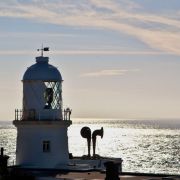The waters surrounding Cornwall’s most westerly point, Lands End, have always been known for their treacherous nature for it is here that the many bodies of water merge and where, in stormy weather, the view from shore is one of a furious, boiling sea pounding against granite. William Turner encapsulated the tumult in his watercolour entitled 'Longships Lighthouse, Land's End'. Since man first took to the water, this area has seen many a boat come to grief on its rocks and, indeed, the local area is famed for having taken advantage of the regular spoils from wrecked ships. It is even said that certain folk would lure ships to their demise with lights and beacons so that they might benefit from the spilled cargo. Such people were known as wreckers.
No surprise, then, that a lighthouse was proposed for this area as far back as the 1700s. The location was not on shore, but on the largest of a group of rocks about one mile west of Land’s End, known as the Longships. The original tower was a fairly stubby affair, built by a Lieutenant Smith in 1795. Although sturdy, given the ferocity of the sea in inclement weather, the lighthouse’s short stature caused its beam to be interrupted by lively seas and, so, confused its signal. A taller tower replaced it in 1873, designed this time by Trinity House’s engineer James Douglass, also responsible for creating the present Eddystone lighthouse a few years later. It was manned by teams of two keepers until 1967, and was made fully automatic in 1988.






